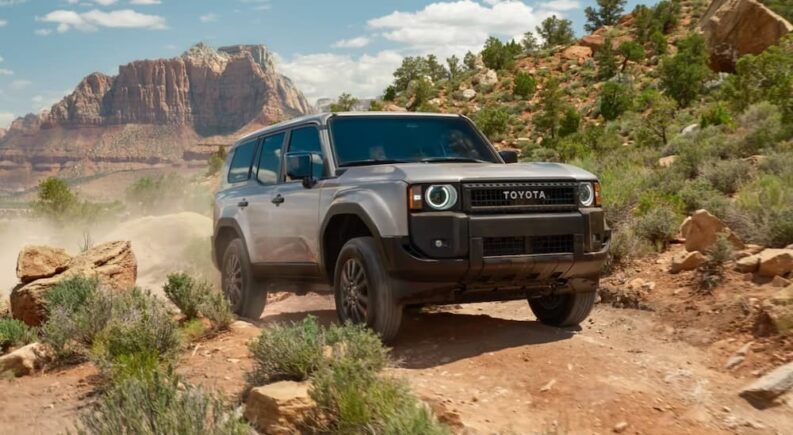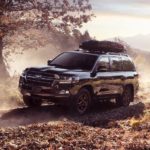It’s been running roughshod on every surface nature could conceive for over 70 years, and soon it’ll be back on American shores. With over 10 million units sold, the Toyota Land Cruiser is one of the most significant vehicles in the history of the world. The first Toyota many markets received was not a Camry or Corolla, but a Land Cruiser. Manifesting the epitome of Toyota’s values of quality, dependability, and reliability, nearly half of all Land Cruisers exceed 250,000 miles. Its versatility has made it the 4WD vehicle of choice from the Australian outback, to the Sahara, to the Siberian tundra. As the saying goes, they’ll let us know how long the FJ engine lasts when the first one dies. The ultimate vote of confidence comes from the United Nations, who use Land Cruisers for humanitarian missions around the world.
One of the most configurable vehicles in the industry, with several wheelbases, powertrains and body styles available to eight generations, the Land Cruiser is more like a Toyota sub-brand than an individual model. As such, the history of the Land Cruiser follows winding and divergent paths, like the many branches of a family tree. To celebrate its American resurrection, we’re going to climb it.
Born of War
One of the great American automotive stories is the development of the Jeep Wrangler, the direct descendant of the ubiquitous Jeep used by American forces in all theaters of World War II. Though development lagged far behind on the other side of the lines, make no mistake that the Land Cruiser’s origins trace back to those same days, and a Japanese effort to muster a utility vehicle of their own.
In the 1950s, the American military supplied the experience and shared knowledge of the Jeep to occupied Japan to develop a locally-produced four-wheeler for use in the Korean War. However, Toyota’s time still had not come, as it was Mitsubishi who won the military contract. Toyota was left to develop their Jeep “BJ” Series vehicle alone, or to abandon the failed project. Luckily, they sensed the potential of this platform, and soldiered on with development for the benefit of the Japanese National Police Reserve. When their design achieved feats that were previously possible only on foot or horseback–summiting the peak of Mt. Atago, and climbing Mt. Fuji to the sixth of ten stations on the old pilgrim route–it was clear that Toyota had developed something special.
The Toyota Jeep had a problem, however. Willys had trademarked the name, and was threatening to sue. Toyota considered their position, recognized the growing reputation of another superb overlander from Britain, and saw their purpose become immediately clear. The name was thus changed to the Toyota Land Cruiser.
The Birth of a Global Phenomenon
The civilian-oriented Land Cruiser “20” Series hit the market in 1955, a time when Toyota’s international presence was functionally non-existent. The vehicle was slightly tweaked from military spec to make it more attractive to drivers, but it was good enough for somebody to buy one in the US in 1958. It was a drop that signaled an impending monsoon as Toyota began to export the “20” Series around the world.
With the “20” Series getting Toyota’s foot in the door and pulling in some cash for development, the “40” Series wasn’t long to arrive in 1961. Though it looked a lot like the “20” Series on the outside, under the hood it was a completely new vehicle. With a three-speed transfer case and a two-speed transmission, better assembly practices for greater durability, and four wheelbase options to choose from, the “40” Series took the Land Cruiser to 50,000 units by 1965 and 100,000 by 1968. In Brazil, the local take on the “40” Series continued production, with iterations of the original FJ engine line. all the way until 2001.
Although one thinks of safe, reliable commuters like the RAV4, Camry and Corolla when they think of Toyota today, the interminable Land Cruiser, popular enough to run for decades without major updates, is the vehicle that made Toyota. In the 1950s, most thriving automotive markets had existed for some time, with well-developed passenger car segments that were difficult for late newcomers to the scene to penetrate. Most new markets, on the other hand, didn’t have much practical use for passenger cars, as they tended to be a little short on paved roads. The Toyota Crown was going to be a tough sell anywhere outside of Japan.
The Land Cruiser was their ace in the hand. The strategy was to use this vehicle, a world-class example in a segment as young as the Japanese auto industry with little to no established competition in any foreign market, to establish their credibility as automakers. It worked. The Land Cruiser was the brand’s best selling vehicle until 1965, when it was surpassed by the reliable, sensible commuter cars Toyota is known for today. People bought these cars because they came from the same house as that most dependable Land Cruiser.
Fulfilling the role of a halo car in this most unusual way, the absolutely interminable nature of the Land Cruiser raised interest in Toyota as a whole, kickstarting their growth into the world’s largest auto manufacturer.
Paths Less Traveled
It wasn’t all automatic, though. Back in the 1960s, Toyota’s keen auto-senses were tingling again. They recognized a growing American interest in marrying the capabilities of these rough-and-tumble trucks with everyday passenger vehicle comforts, giving rise to the “Iron Pig,” the “55” Series of 1967-1979. The first of the Land Cruiser’s lineage of “station wagon” designs (more typically recognized as full-size SUVs in the USA) would prove popular enough to validate its existence, setting Toyota on the path to creating one of the world’s greatest luxury SUVs.
In 1980 the “55” Series was replaced by the “60” Series, then eventually the “80,” “100,” and “200” Series, whose starting price was near $90,000 by its end in 2021. Throughout this evolution, the “station wagon” Land Cruiser claimed milestone after milestone in the development of a benchmark luxury overlanding SUV.
- 1989: “80” Series offers the first full-time 4WD system on the market, with a center differential designed to enable comfortable on-road driving.
- 1998: “100” Series becomes the first V8 Land Cruiser, and abandons a solid front axle for a fully independent front suspension, improving road handling at the expense of some off-road performance, but improving articulation.
- 2007: “200” Series introduces the world to off-road cruise control, a.k.a. CRAWL control, and Japan’s first Kinetic Dynamic Suspension System (KDSS), which uses hydraulics to automatically and instantaneously simulate a sway bar disconnect when needed while enabling the use of heavy sway bars for better on-road handling.
- 2021: “300” Series offers the world’s first electronic KDSS, enabling independent control of the front and rear stabilizers where they had previously been paired by hydraulic lines. This feature of the GR Sport version enables better handling after landing from jumps, and reduces vibrations in the passenger space. Sadly, we did not get this version in the US except in the guise of the Lexus LX.
Though initially presented merely as a family-suitable variant of the classic “FJ40” Land Cruiser, the station wagon lineage inexorably closed the gap between luxury cars and SUVs throughout the ‘90s until Lexus adopted its platform for the LX, creating what Car and Driver called “the Bentley of SUVs” back when that notion seemed like a fairytale. The Land Cruiser’s relatively understated styling and behemoth proportions belie its sheer capabilities and the attention paid to passenger comfort. For years, it has operated in the space between Lexus and the Sequoia, offering the opportunity to discreetly enjoy the luxuries within.
Land Cruiser Diaspora
Around the world, the Land Cruiser story has been more nuanced. The “40” Series’ true successor, the “70” Series, is a “heavy duty” truck offered in short and long wheelbases around the world, aiming to preserve at all costs the sheer durability and capability the name is known for.
The “70” Series, introduced in 1980, is sold around the rest of the world, with assembly facilities in Portugal, South America, and Japan. While the American market has received three iterations of the station wagon, the rest of the world has enjoyed a steady stream of the same functional design for more than 40 years!
Americans aren’t the only ones interested in creature comforts and daily-drivable overlanders, though. Thus Toyota developed a light-duty version of the “70” Series which would eventually become the 1990 “70” Prado Series. With urbanite-informed styling and simplified configuration options as a tradeoff, the Prado lineage would follow the path of the station wagon towards luxury. Even in “70” Series guise, it would adopt a roadworthy coil spring front suspension that also dramatically improved articulation capabilities.
The Prado was popular, selling nearly half a million units, but it was never sold in the US. Instead, it had to sneak its way in. Since the mid-90s, three generations of the Prado Series have underpinned the Toyota 4Runner and Lexus GX, which completely replaced the Land Cruiser in Canada in 1996. The “120” Prado Series was also the basis of the wonderfully retro Toyota FJ Cruiser.
Like the station wagon, the Prado lineage claims a number of industry milestones for its own including:
- 2002: “120” Prado Series offers the world’s first electronic hill start assist system.
- 2009: “150” Prado Series becomes the first in the world to supply an electronically-controlled flush-with-floor folding third row bench seat.
Ready for Whatever Comes Next
Today, the rumors are flying. Toyota’s truck lineup overhaul is well underway, and nobody’s quite sure what to expect from a sixth-generation 4Runner or, dare I say it, a “400” Series Land Cruiser. Could we see a “180” Prado Series type of Land Cruiser instead, focusing on urban style and family utility, while the new 4Runner leans into off-roading on the same platform? Will it be hybridized, or even electric?
It should be impossible to say. But the consistency with which the Land Cruiser has delivered Toyota’s core values for 70 years tells me it might be more predictable than you’d think. This vehicle which has always delivered evolutionary style and revolutionary underpinnings will last forever, as far as anyone can tell. It continues to serve as a halo for Toyota’s core values of quality, dependability and reliability. Unquestioned capability and understated luxury define one of the most consistent models in the history of the industry.
I’m willing to bet that MotorTrend has it right, that the new Land Cruiser will be a hybridized mid-size three-row SUV with quasi-luxury appointments, combining the best of Sequoia and 4Runner with that understated upper class aura signature to Land Cruiser design. The one thing we can be sure of is that no matter where you want to go in this world, a Land Cruiser can get you there, and bring you home safely. That’s what Toyota’s all about.




